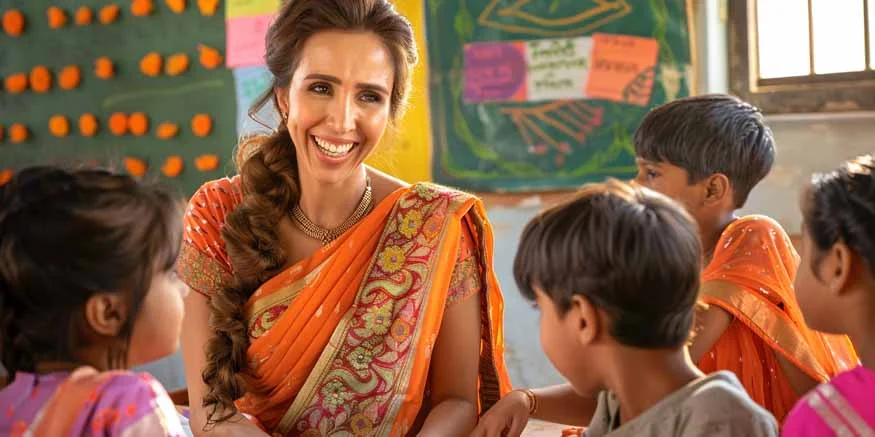With so many methodologies aiming at acing kids preschool learning, most new teachers may find it baffling to begin with. However, it’s mostly about a few key skills and techniques that can help you make a difference in these formative years. To help you get started, we have summarised some of the best teaching techniques to help you gain confidence about how to teach pre-primary kids in the best possible way.
Also read: Top Preschool Teaching Methods Worldwide
- Attractive, organised, and fun classroom
- Right start to the day
- Predictable routine and schedule
- Observation and support
- Hands-on learning
- Fine motor practice
- Playful learning
- Library time
- Playing music regularly
- Keeping it fun
A colourful and bright classroom sets a welcoming atmosphere for the little kids. Organising the classroom well with different art, reading, and writing stations, all duly labelled and colour-coded helps the preschoolers find things around easily. Keeping tissues, sanitizers, gloves, and napkins helps manage meal times, spills, and mess easily.
Pre-schoolers may struggle with the new routine of waking up early, getting ready for school, and leaving their parents behind. They might be anxious and nervous while coming to school in the first weeks. One of the best ways to help them out is to begin every day on a cheerful note! Greeting each child with warmth and enthusiasm, while helping them with simple tasks like putting their backpack and coat in their cubbies, choosing a book, and finding their place in the class, helps set the mornings right!
This, followed by a quick morning circle time with welcome songs and stories can help the children ease into the day’s schedule.
Also read: Classroom Charts: Boosting Teaching Effectiveness
Young kids thrive on routine. Knowing what comes next after a certain activity, storytime, or snack break, helps keep the meltdowns away. It would help the teacher manage the class better if group gatherings were kept short and the preschoolers remained engaged through play and activities as per their short attention span.
Observing each child keenly helps the teacher understand their unique abilities, challenges, interests, and potential. The teacher must try and understand every student’s needs, intellectual level, and special needs. Similarly, it’s important to keep the parents updated on their child’s progress, day’s schedule, meal times, etc. Just like the kids, it could be the first time for most parents too. Therefore, a supportive and encouraging teacher makes a good difference in building that initial rapport and confidence.
Sensory materials not only help keep curious minds busy and calm, but also provide a unique opportunity for open-ended thinking, language development, and collaborative play.
Selecting simple, durable, and open-ended educational toys encourages the children to explore, create, and stretch their imagination and reasoning skills.
Also read: Pros and Cons of Traditional Teaching Methods
Sandpaper alphabet tracing, using clothespins, tweezers, and crayons, helps the children develop a pincer grasp and prepares them for pre-writing activities that help strengthen their fine motor skills.
Using games and pretend play to introduce and practice language, numbers, social skills, and creativity, is key to a fun-filled classroom. Scavenger Hunt, Simon Says, I Spy, and Put the Tail on the Donkey, are a few of the engaging games and activities that can keep the children entertained while learning the basics.
Introducing preschoolers to books is vital in their formative years. Stocking up on picture books and board books on a variety of topics helps the kid develop the independence of handling books and learning various concepts easily.
Also read: CBSE Teaching Methodologies for Young Learners
Kinder music, rhymes, and welcome songs help the children relax and chime in together while developing their listening, speaking, and social skills.
As a preschool teacher, while you may have a multitude of things on your mind, it is important to keep it fun and flexible. Initiating open-ended conversations, joining in with their silly antics, or even just playing together, can help keep the environment happy and cheerful. Respecting each child’s ideas and preferences would help the teacher gain an idea of how to channel these bundles of energies to their best potential.
Along with the above, it is important to make sure the classroom is easily accessible and child-proofed with all crucial safety measures in place.
- Keep tiny parts and items out of reach of children
- Ensure all items are clean and properly sanitised
- The floor should be kept dry and clutter-free at all times
- Ensure easy accessibility of classroom and staircase safety
- Keep the activities at a comfortable height
- Help kids learn to resolve conflicts without physical touch
- The rugs and mats should be slip-proof
- Make sure the furniture, drawers, and corners are child-proofed
- Encourage open communication about any inconvenience
- Ensure all-around supervision of each child within and beyond the classroom
Also read: ICSE Teaching Methods for Young Learners
A preschool teacher is one of the first few people a child learns to confide in. At that formative stage, the teacher needs to provide that care and emotional outlet for the child. All preschool teaching methods insist on keeping it fun and engaging for the children. And it is in these magic years that the child is capable of making incredible progress!
If you are a preschool teacher, don’t forget to celebrate your successes as you can see the subtle changes and progress made over a year. The impact and memories are etched forever!









